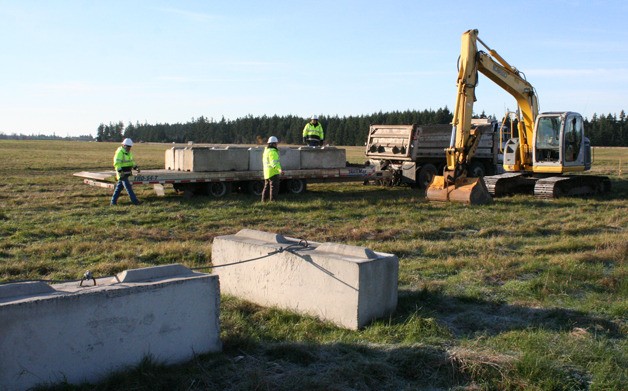The recent placement of cement blocks around Outlying Field Coupeville has caused neighboring residents to criticize the appearance as well as the Navy’s failure to consult the community.
More than 1,000 40-inch cement Jersey barriers have been placed around the perimeter of the OLF, stamped with the words “government property, do not trespass.” Additional fencing will also be placed at the entryways.
Maryon Attwood, a member of the Citizens of Ebey’s Reserve, or COER, said she feels that the barriers are a “keep out” sign to island visitors and that the Navy should have consulted neighbors about the appearance.
“That’s my group’s continuing problem with them,” Attwood said. “They talk the talk but they don’t walk the walk.”
COER had speculated that the cement blocks were an added security as a result of their criticism of the jet noise and the Navy’s intention to resume touch-and-go operations in January.
The group alleges that the Navy’s new EA-18G Growlers are louder than previous aircraft and that the Navy is performing more operations at OLF than estimated in recent years. It filed a lawsuit last summer over the matter.
Navy officials say they have intended to increase security at the field for several years.
“We’ve been trying to get those blocks out there for some time,” said Bill MacMillan, Whidbey Island Naval Air Station airfield manager and deputy operations officer. “I had this identified as a security risk a long time ago.”
MacMillan said he’s proposed additional security at OLF since he took the position in 2005, but it took a drunk driver who caused damage to OLF’s arresting gear to raise the priority of the project.
In March of 2007, 46-year-old Coupeville resident James Slone lead police on a high-speed chase onto OLF, according to court documents. Slone pleaded guilty and was convicted in May 2007 of attempting to elude police and driving under the influence.
According to the police report, Slone sped up and down the runway, running over arresting gear which caused the vehicle to spark and smoke. A tire was also torn off the rim.
The drunk driving incident was compounded by other incidents such as vandalism, driving onto the property and “doing donuts,” harassment of onsite military staff and bullet holes in structures, according to NAS Whidbey’s Public Affairs Officer Mike Welding.
A first round of blocks was placed out at OLF in 2009 at the easiest entry points to make it more difficult to enter, and protecting the Navy’s millions of dollars worth of equipment at the field, Welding said.
The total cost to finish the barrier project was $115,297, Welding said.
Attwood said she wondered why the Navy is doing it now and not back in 2005 when they first identified the need.
“The story seems weak,” Attwood said. “To me it looks like a power play and I think that’s how a lot of people view it.”
Welding said that while a number of people have contacted the Navy about the perceived “sudden” added security, this type of project takes time.
“You have to put forth a request to get funding through the Department of Defense where things are prioritized according to need,” Welding said.
Welding said he has seen funding requests for additional security at OLF dating back to 2008, but requests may have been made prior to that.
A main complaint of Attwood and some other area residents is that the Jersey barriers are an eyesore in an area that abuts Ebey’s Landing National Historical Reserve.
Jackie Queen, an environmental planner for the Navy base, said that the Navy contacted the appropriate state agencies as well as local tribes before resuming the project. Queen also said that the barriers along Highway 20 were placed behind existing bushes in the hopes that the blocks will be obscured as the plants grow.
According to the National Historic Preservation Act, projects involving national parks like Ebey’s Reserve must be approved by the state Historic Preservation Officer, according to Greg Griffith, deputy state historic preservation officer.
The Navy contacted the state office Sept. 11 and was issued a letter later that month stating that there would be “no adverse effect” to the historic property due to the additional security, Griffith said.



